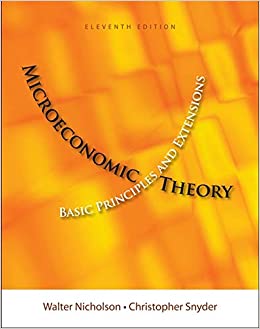
Microeconomic Theory 11th Edition by Walter Nicholson,Christopher Snyder
Edition 11ISBN: 978-1111525538
Microeconomic Theory 11th Edition by Walter Nicholson,Christopher Snyder
Edition 11ISBN: 978-1111525538 Exercise 2
A monopolist faces a market demand curve given by
Q = 70 - p
a. If the monopolist can produce at constant average and marginal costs of AC = MC = 6, what output level will the monopolist choose to maximize profits? What is the price at this output level? What are the monopolist's profits?
b. Assume instead that the monopolist has a cost structure where total costs are described by

With the monopolist facing the same market demand and marginal revenue, what price-quantity combination will be chosen now to maximize profits? What will profits be?
c. Assume now that a third cost structure explains the monopolist's position, with total costs given by

Again, calculate the monopolist's price-quantity combination that maximizes profits. What will profit be? Hint: Set MC = MR as usual and use the quadratic formula to solve the second-order equation for Q.
d. Graph the market demand curve, the MR curve, and the three marginal cost curves from parts (a), (b), and (c). Notice that the monopolist's profit-making ability is constrained by (1) the market demand curve (along with its associated MR curve) and (2) the cost structure underlying production.
Q = 70 - p
a. If the monopolist can produce at constant average and marginal costs of AC = MC = 6, what output level will the monopolist choose to maximize profits? What is the price at this output level? What are the monopolist's profits?
b. Assume instead that the monopolist has a cost structure where total costs are described by

With the monopolist facing the same market demand and marginal revenue, what price-quantity combination will be chosen now to maximize profits? What will profits be?
c. Assume now that a third cost structure explains the monopolist's position, with total costs given by

Again, calculate the monopolist's price-quantity combination that maximizes profits. What will profit be? Hint: Set MC = MR as usual and use the quadratic formula to solve the second-order equation for Q.
d. Graph the market demand curve, the MR curve, and the three marginal cost curves from parts (a), (b), and (c). Notice that the monopolist's profit-making ability is constrained by (1) the market demand curve (along with its associated MR curve) and (2) the cost structure underlying production.
Explanation
a)
A monopolist faces a market demand cu...
Microeconomic Theory 11th Edition by Walter Nicholson,Christopher Snyder
Why don’t you like this exercise?
Other Minimum 8 character and maximum 255 character
Character 255


